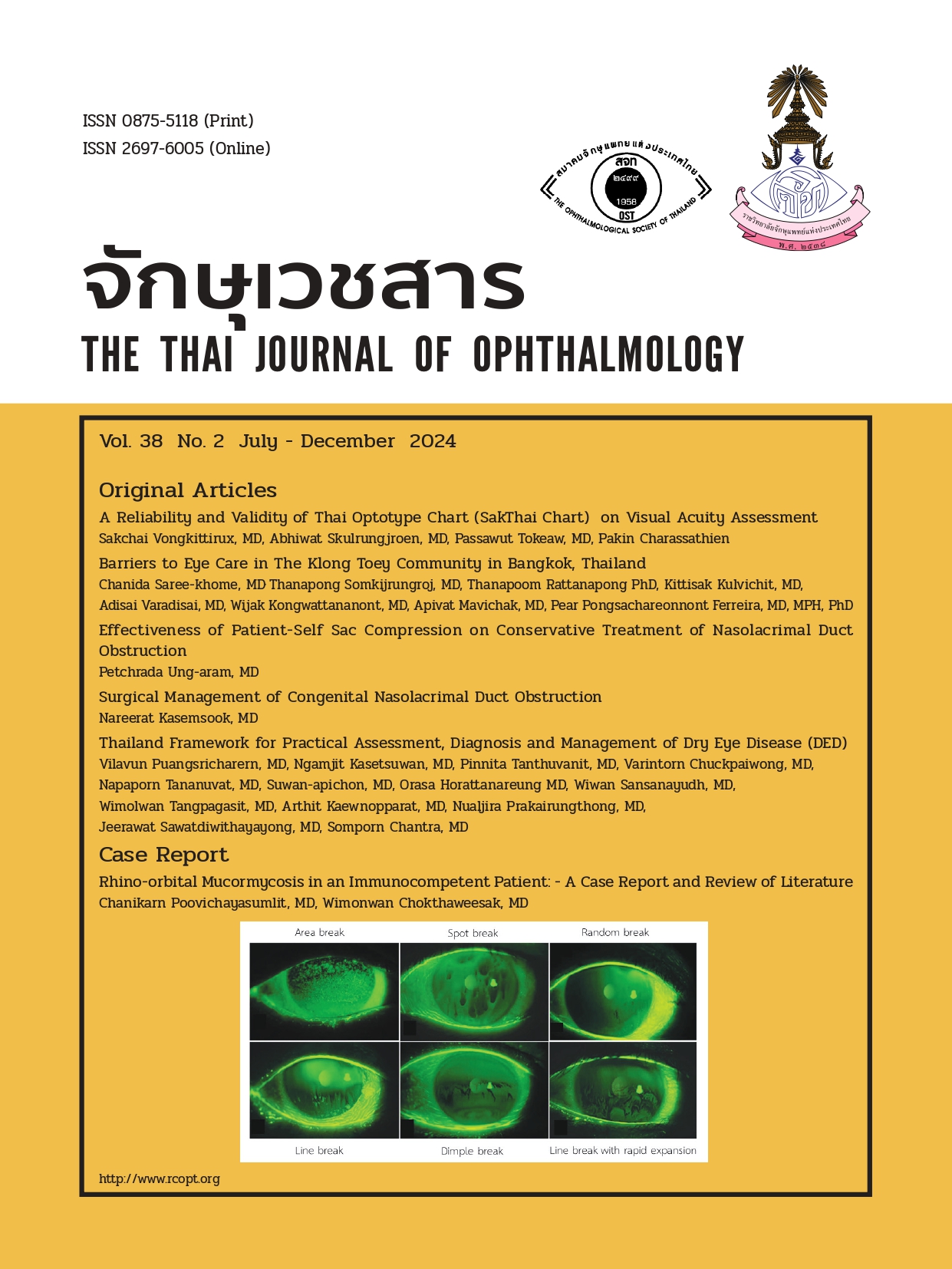การตรวจสอบความเชื่อมั่นและความเที่ยงตรงของแผ่นทดสอบความ สามารถในการมองเห็นภาษาไทย (SakThai Chart) สำหรับการวัด สมรรถภาพการมองเห็น
คำสำคัญ:
ความเชื่อมั่น, ความเที่ยงตรง, สมรรถภาพการมองเห็น, แผ่นทดสอบความสามารถ, การมองเห็นสเนลเลน, แผ่นทดสอบการมองเห็นภาษาไทยบทคัดย่อ
วัตถุประสงค์: เพื่อดรวจสอบความแม่นยำของแผ่นทดสอบความสามารถในการมองเห็นภาษาไทย (SakThai Chart) สำหรับการวัดสมรรถภาพการมองเห็น
แบบการศึกษา: A cross-sectional study, A test of reliability and validity โดยมีผู้เข้าร่วมวิจัยจำนวน 124 คน ที่มีอายุ 20-65 ปี ที่เข้ามาตรวจรักษาที่แผนกจักษุ โรงพยาบาลธรรมศาสตร์ฯ เข้าทดสอบสมรรถภาพการมองเห็นตามความสมัครใจ โดยอ่านแผ่นทดสอบการมองเห็นแบบตัวเลข (numeric optotype chart) และแผ่นทดสอบการมองเห็นภาษาไทย (SakThai Chart) ด้วยตาข้างขวาและบันทึกผล จากนั้นวิเคราะห์ข้อมูลด้วยโปรแกรม SPSS เวอร์ชัน 25 โดยความเชื่อมั่นของเครื่องมือ ใช้สถิติทดสอบ Pearson correlation และความเที่ยงตรงของเครื่องมือใช้สถิติทดสอบ Item-objective Congruent (IOC) และ Paired t-test
ผลการศึกษา: แผ่นทดสอบความสามารถการมองเห็นภาษาไทย (SakThai chart) มีค่า Pearson corelation คือ 0.992 ซึ่งถือว่าเครื่องมือนี้มีความเชื่อมั่นสูงเมื่อเทียบกับการทดสอบความสามารถการมองเห็นแบบสเนลเลน และเมื่อทดสอบความเที่ยงตรงของเครื่องมือ พบว่า IOC มากกว่า 0.5 ในทุกหัวข้อ และ Paired t-test ไม่มีความแตกต่างอย่างมีนัยส่าคัญของทั้งสองเครื่องมือ (P-value = 0.217)
สรุป : แผ่นทดสอบความสามารถในการมองเห็นภาษาไทย (SakThai Chart) มีค่าความเชื่อมั่นและมีความเที่ยงตรงของเนื้อหาสูง และสามารถใช้ทดแทนกับแผ่นทดสอบการมองเห็นแบบสเนลเลน (Snellen Chart) ได้
คำสำคัญ: ความเชื่อมั่น, ความเที่ยงตรง, สมรรถภาพการมองเห็น, แผ่นทดสอบความสามารถ, การมองเห็นสเนลเลน, แผ่นทดสอบการมองเห็นภาษาไทย
References
Snellen H. Test-types for the Determination of the Acuteness of Vision. Utrecht: P.W. van de Weijer; 1862.
de Jong PTVM. A history of visual acuity testing and optotypes. Acta Ophthalmol. 2022;100(7):e1337-e1349.
Rozhkova G, Lebedev D, Gracheva M, Rychkova S. Optimal Optotype Structure for Monitoring Visual Acuity. Perception. 2017;46(3-4):321-331.
Sailoganathan A, Siderov J, Osuobeni E. A new Gujarati language logMAR visual acuity chart: Development and validation. Indian J Ophthalmol. 2013;61(10):557-561.
Ruamviboonsuk P, Tiensuwan M. Visual acuity measurement using a new Thai language logarithmic visual acuity chart and a standard chart. J Med Assoc Thai. 2002;85(7):808-815.
Bailey IL, Lovie-Kitchin JE. Visual acuity testing. Fromthe laboratory to the clinic. Vision Res. 2013;90:2-9.
Ferris FL 3rd, Kassoff A, Bresnick GH, Bailey I. New visual acuity charts for clinical research. Am J Ophthalmol. 1982;94(1):91-6.
Dandona L, Dandona R, Srinivas M, et al. Moderate visual impairment in India: the Andhra Pradesh Eye Disease Study. Br J Ophthalmol. 2002;86(4):373-7.
Bourne RR, Rosser DA, Sukudom P, et al. Evaluating a new logMAR chart designed to improve visual acuity assessment in population-based surveys. Eye (Lond). 2003;17(6):754
Rosser DA, Laidlaw DA, Murdoch IE. The development of a "reduced logMAR" visual acuity chart for use in routine clinical practice. Br J Ophthalmol. 2001;85(4):432-6.
Arditi A, Cagenello R. On the statistical reliability of letter-chart visual acuity measurements. Invest Ophthalmol Vis Sci. 1993;34(1):120-9.
Jenchitr W, Hanutsaha P, Iamsirithaworn S, et al. The national survey of blindness, low vision and visual impairment in Thailand. J Med Assoc Thai. 2007;90(9):1897-903.
Wong TY, Loon SC, Saw SM. The epidemiology of age related eye diseases in Asia. Br J Ophthalmol. 2006;90(4):506-11.
World Health Organization. Universal eye health: a global action plan 2014-2019. Geneva: WHO; 2013.
Kocur I, Resnikoff S, Foster A. Visual impairment and blindness in Europe and their prevention. Br J Ophthalmol. 2002;86(7):716-22.
Elliott DB, Yang KC, Whitaker D. Visual acuity changes throughout adulthood in normal, healthy eyes: seeing beyond 6/6. Optom Vis Sci. 1995;72(3):186-91.
Downloads
เผยแพร่แล้ว
ฉบับ
บท
License
Copyright (c) 2024 จักษุเวชสาร

This work is licensed under a Creative Commons Attribution-NonCommercial-NoDerivatives 4.0 International License.
The Thai Journal of Ophthalmology (TJO) is a peer-reviewed, scientific journal published biannually for the Royal College of Ophthalmologists of Thailand. The objectives of the journal is to provide up to date scientific knowledge in the field of ophthalmology, provide ophthalmologists with continuing education, promote cooperation, and sharing of opinion among readers.
The copyright of the published article belongs to the Thai Journal of Ophthalmology. However the content, ideas and the opinions in the article are from the author(s). The editorial board does not have to agree with the authors’ ideas and opinions.
The authors or readers may contact the editorial board via email at admin@rcopt.org.


